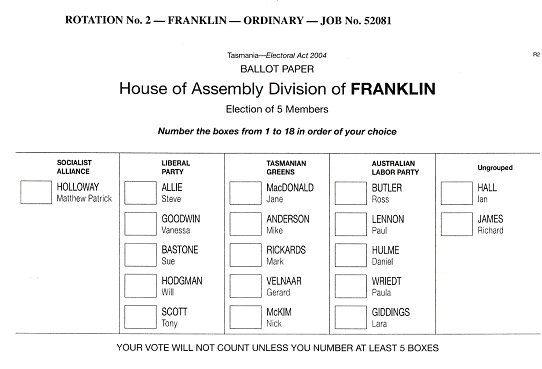Summary: Victoria’s Legislative Assembly should be directly elected by a single transferable vote (quota-preferential) form of proportional representation. The voting and counting systems should resemble the Hare-Clark systems used in the Tasmanian House of Assembly and the Australian Capital Territory Legislative Assembly, but with the transfer values described below.
Parliament structure: Parliament should consist of an odd number of Members. The Speaker should have a deliberative vote only. Where the voting is equal the question should be determined in the negative.
Multi-member electoral districts: Members should be elected from multi-member districts; preferably 5-member districts (this ensures proportionality whilst retaining local representation). Each district should elect an odd number of Members (this ensures that in each district, a majority of votes elects a majority of Members). Each district should elect the same number of Members, and each Member should represent the same number of voters, within a range of plus/minus ten per cent (this ensures that each vote has equal value).
Neutral ballot-paper format: The ballot paper format should as clear and simple as practicable, similar to the ballot papers used for the Tasmanian Legislative Assembly. A ballot paper statement should advise voters to mark at least as many preferences as there are vacancies, and encourage them to mark further preferences. A ballot should be considered formal if it is marked with a unique first preference (this ensures that voters have the maximum possible flexibility in communicating their preferences). Ballot papers should be printed with the columns and names of candidates rotated in different positions, using Robson Rotation (this ensures that each candidate has equal chance of attracting votes).

Accurate transfer values: Transfer values should be determined using the Meek method prescribed in Schedule 1A of New Zealand’s Local Electoral Regulations 2001; or the Weighted Inclusive Gregory Transfer method presently used for the transfer of surplus votes for Western Australia’s Legislative Council.
Direct Election of all Members: The system of filling casual vacancies should correspond with the countback system prescribed for use in the Tasmanian and ACT Assemblies (this ensures that all Members are always directly elected by the people).
Example: Victoria’s Legislative Assembly should comprise 95 Members returned from 19 districts each returning 5 Members.
